Difference between revisions of "CyberShake UCERF3 Migration"
| Line 18: | Line 18: | ||
[[File:UCERF3_Subset_Curve_SBSM_comparison.png]] | [[File:UCERF3_Subset_Curve_SBSM_comparison.png]] | ||
[[File:UCERF3_Subset_Curve_FIL_comparison.png]] | [[File:UCERF3_Subset_Curve_FIL_comparison.png]] | ||
| + | |||
| + | == Aleatory Magnitude Variability Test == | ||
| + | |||
| + | UCERF2 by default applied aleatory magnitude variability to all non-floating rupture sources. | ||
| + | |||
| + | For example, the SAF S. Mojave characteristic source has 7 ruptures with identical full segment rupture surfaces but varying magnitudes and probabilities (applied as a truncated gaussian with sigma=0.12, truncated on either side at 2 sigma). Here are the ruptures and their associated probabilities: | ||
| + | |||
| + | {| | ||
| + | ! Source ID | ||
| + | ! Rupture ID | ||
| + | ! Magnitude | ||
| + | ! Probability | ||
| + | |- | ||
| + | | 90 | ||
| + | | 0 | ||
| + | | 6.95 | ||
| + | | 7.77415e-06 | ||
| + | |- | ||
| + | | 90 | ||
| + | | 1 | ||
| + | | 7.05 | ||
| + | | 4.2332184e-05 | ||
| + | |- | ||
| + | | 90 | ||
| + | | 2 | ||
| + | | 7.15 | ||
| + | | 0.000109296016 | ||
| + | |- | ||
| + | | 90 | ||
| + | | 3 | ||
| + | | 7.25 | ||
| + | | 0.00015457721 | ||
| + | |- | ||
| + | | 90 | ||
| + | | 4 | ||
| + | | 7.35 | ||
| + | | 0.00012129413 | ||
| + | |- | ||
| + | | 90 | ||
| + | | 5 | ||
| + | | 7.45 | ||
| + | | 5.2423315e-05 | ||
| + | |- | ||
| + | | 90 | ||
| + | | 6 | ||
| + | | 7.55 | ||
| + | | 1.0574104e-05 | ||
| + | |} | ||
Revision as of 18:39, 14 May 2015
This page will be used to document progress migrating CyberShake to UCERF3
Contents
GMPE Downsampling Test
This tests creates a downsampled UCERF3 forecast for southern california. Every rupture that is outside of Southern California (using the white dashed dividing line seen in the figure on the front of the UCERF3 Fact Sheet) is removed. If a rupture is partially outside, it is removed and its rate is added to the largest subset rupture which is entirely inside the region. This results in 64992/253706 ruptures retained for UCERF3 Fault Model 3.1.
MFD Comparison
The following figure shows the resulting MFD following this downsampling proceedure (blue curve). The original MFD (black curve) and MFD were we to just exclude partial ruptures rather than add their rate to subset ruptures (green curve) are also shown. Note that these are nucleation MFDs (as opposed to participation) and only include supra-seismogenic fault ruptures.
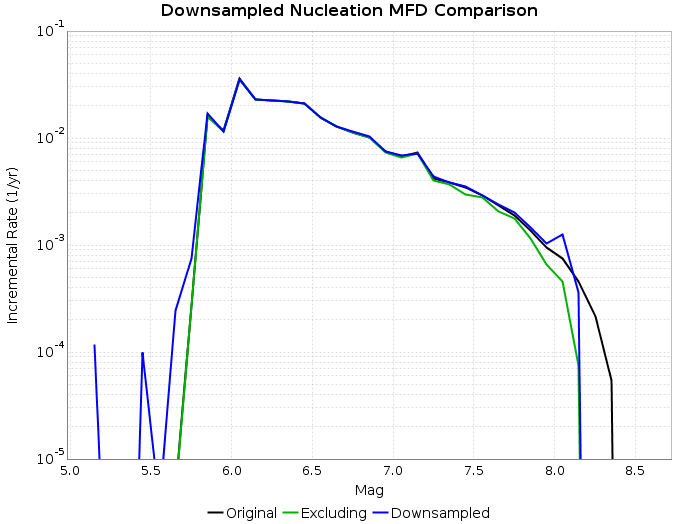
The following figure shows a participation MFD for the Mojave (S) section of the San Andreas to better illustrate the consequences of applying this algorithm (same colors).
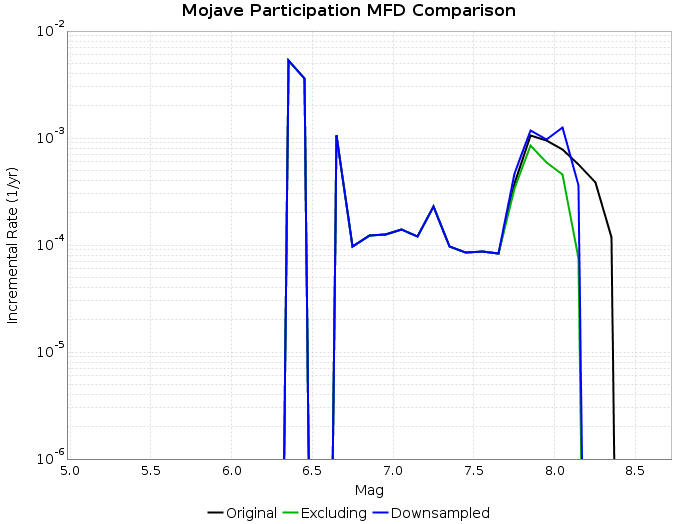
Hazard Curve Comparison
The following figures show the hazard curve calculations using the average NGA-West2 GMPE following this downsampling proceedure (blue curves). The original curve (black curves) and curve were we to just exclude partial ruptures rather than add their rate to subset ruptures (green curves) are also shown. These calculations are for 3 second SA and include site effects (Wills 2006 Vs30 and Z1.0/2.5 from CVM-S4.26).
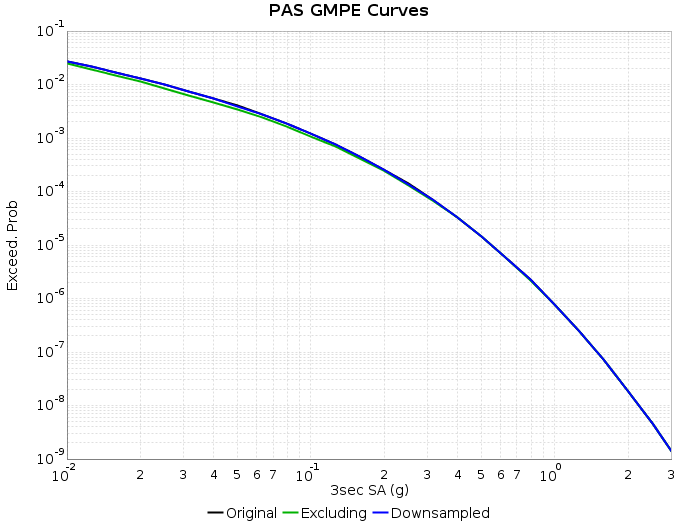
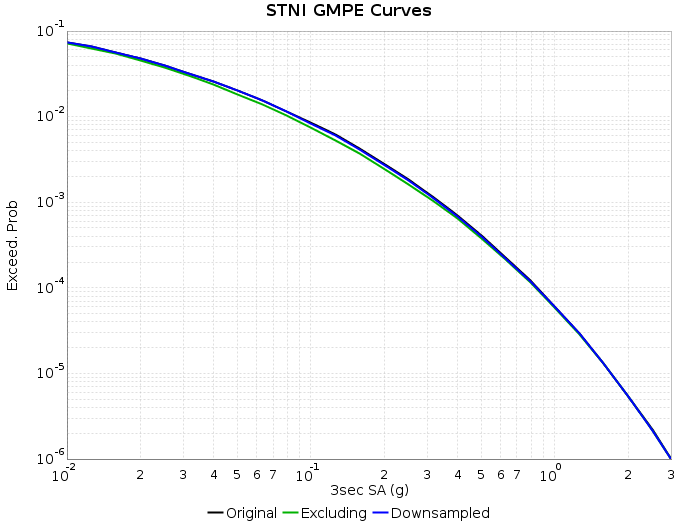
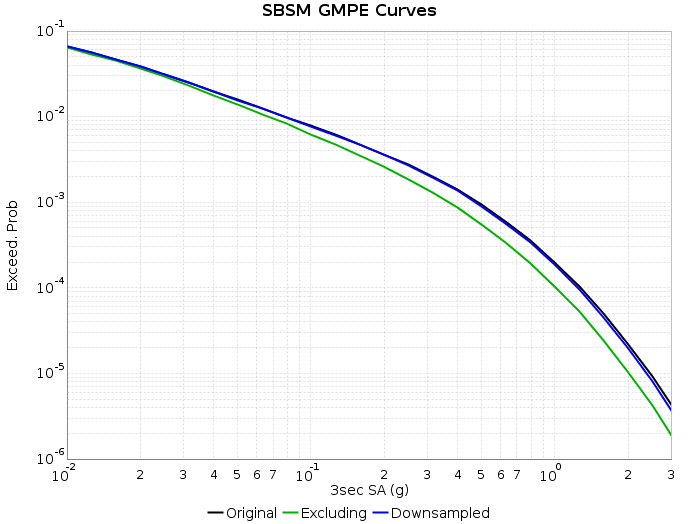
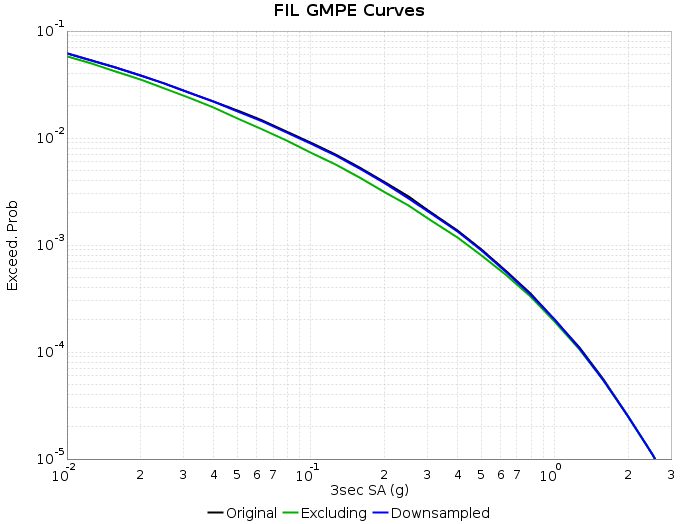
Aleatory Magnitude Variability Test
UCERF2 by default applied aleatory magnitude variability to all non-floating rupture sources.
For example, the SAF S. Mojave characteristic source has 7 ruptures with identical full segment rupture surfaces but varying magnitudes and probabilities (applied as a truncated gaussian with sigma=0.12, truncated on either side at 2 sigma). Here are the ruptures and their associated probabilities:
| Source ID | Rupture ID | Magnitude | Probability |
|---|---|---|---|
| 90 | 0 | 6.95 | 7.77415e-06 |
| 90 | 1 | 7.05 | 4.2332184e-05 |
| 90 | 2 | 7.15 | 0.000109296016 |
| 90 | 3 | 7.25 | 0.00015457721 |
| 90 | 4 | 7.35 | 0.00012129413 |
| 90 | 5 | 7.45 | 5.2423315e-05 |
| 90 | 6 | 7.55 | 1.0574104e-05 |